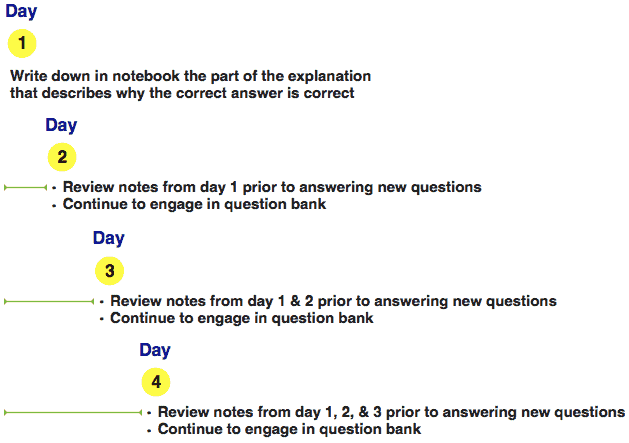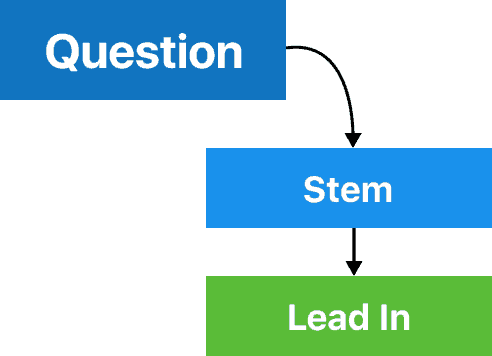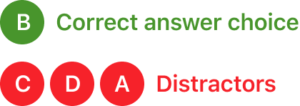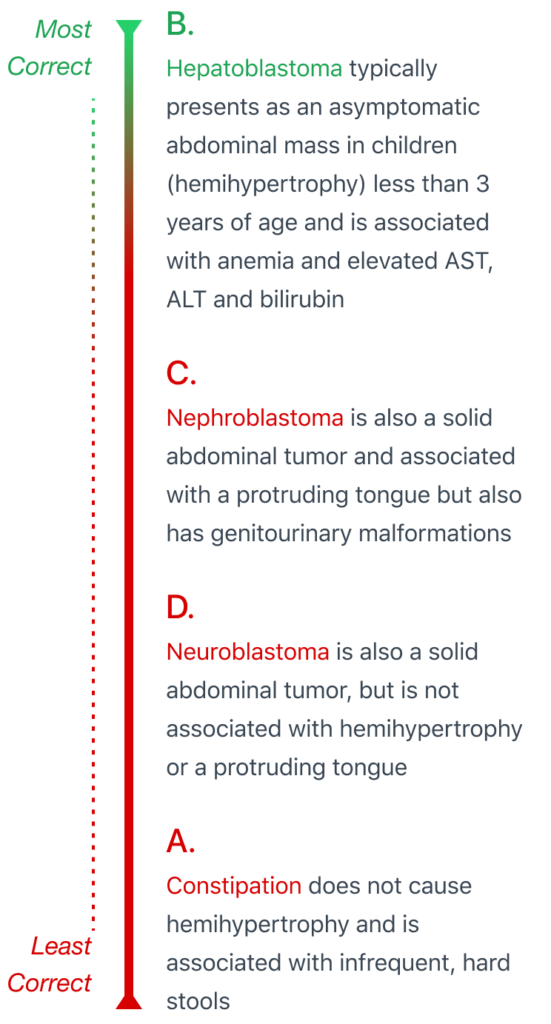How to Increase Your Pediatric Board Exam Score

This article covers two easy strategies to help increase your Pediatric Board Exam score. While there is no magic pill or wand that will increase your score, these two techniques are useful, easy to implement, and only require a little of your time.
The first strategy is to identify what you don’t know. Sounds easy, right? The key is to go through a curriculum and identify what you don’t know—not what you are weak at—but what you don’t know. The second strategy is to take advantage of human error. Humans write tests, and humans make errors. By paying attention to five types of flaws that question writers make, you can narrow down an answer choice to either the correct answer or a 50/50 probability—even without knowing anything about the topic. By combining these two strategies, you’ll be able to increase your Pediatric Board Exam, which would be the difference between passing or failing. Let’s get started.
Strategy 1: Determining your unknown unknowns
As you begin to study for your exam there are areas you are comfortable with. Maybe you have a special interest in nephrology and feel confident with any question that might be asked on Fanconi syndrome. Because you are confident in nephrology, you spend less time reviewing it. This is one of your known knowns. There is little utility in spending too much time on your known knowns when preparing for your exam.
Suppose you feel that your understanding of liver disease is poor. Hepatic encephalopathy is still just a term to you. You don’t feel confident that you understand how or why it occurs, or how to manage the condition. Liver disease is a known unknown. But because you recognize this specific deficiency, you can target your learning to diseases of the liver.
Once you start to focus your learning, you’ll come across many concepts and ideas that you may know nothing about. These are your unknown unknowns, a concept created by psychologists Joseph Luft and Harrington Ingham. It is part of their “Johari window,” a tool that helps users identify blind spots about themselves and others.
Known unknowns are things you’re aware that you don’t know—you can recognize that you don’t understand them. Unknown unknowns, however, are unexpected because you don’t know they exist.
The way to supercharge your board exam score is to identify your unknown unknowns. It takes a little effort, but the steps are rather easy. All you need are two things:

The system works like this.
Step 1: Answer a question from a question bank. If you get the answer wrong, read the explanation. Then write down in your notebook the part of the explanation that describes why the correct answer is correct. This process helps to identify your unknown unknowns. Subsequently, if there is any other information that you did not know or somewhat knew, record it as well in your notebook under the same topic.
You should do this for every question you get incorrect. I also encourage it for questions you may have answered correctly but discovered new information in the explanation that you previously did not know.
Step 2: Start each study session by reviewing your notebook that contains your unknown unknowns. As you do more questions, you will get questions wrong on topics already recorded in your notebook. For example, if you answer a question incorrectly on which age group most commonly presents with juvenile ankylosing spondylitis, you’ll record in your notebook something like “Juvenile ankylosing spondylitis: Epidemiology includes boys around 12 years old.” Two weeks later when you can’t name the physical exam maneuver characterized by limited lumbosacral flexion with forward bending, you should go back through your notebook to find your first entry on juvenile ankylosing spondylitis and add the Schober test as part of the evaluation.
After a month or two of recording your incorrect answer explanations, you will have a filled notebook of your unknown unknowns and maybe many of your known unknowns. If you do this on a consistent basis and get through 1,000 to 2,000 question bank questions for a 300-question standardized exam, you’ll have identified most of your blind spots that questions can be asked about. You will convert your unknown unknowns to known knowns.
You can use the same system and process to prepare for all standardized exams.

With the Pediatric Board Exam waiting for you, now is the perfect time to begin this system. It leaves time to accumulate your unknown unknowns.
Strategy 2: Taking advantage of human error
Earlier in this post, I mentioned that you’ll need two things to supercharge your standardized exam score: a notebook and time. The notebook you can buy anytime. However, time disappears.
Taking the time to identify your unknown unknowns will prepare you for the exam. But, we know five ways you can improve your score simply by showing up to your exam.
You can use the errors made by question writers to boost your score.
The Anatomy of a Question
First, let’s understand the anatomy of a question.

A 3-year-old boy, former 28-week preemie, presents with a large, firm, nontender abdominal mass. Findings on physical examination reveal pallor, hemihypertrophy, and a protruding tongue. A smooth, round abdominal mass approximately 6 cm in diameter is palpated on the right upper quadrant of his abdomen. The remainder of the physical examination findings are normal. Initial laboratory values show a white blood cell count of 10,500 with 10% polymorphonuclear leukocytes, 8% lymphocytes, 4% monocytes, and 1% eosinophils. Hemoglobin is 8, mean corpuscular volume 72, and platelets 600. Aspartate aminotransferase is 140 U/L, alanine aminotransferase is 125 U/L, total bilirubin is 6 mg/dL, and alpha-fetoprotein is 150,000 mcg/mL. What is the most likely diagnosis?
A question is made up of the stem and the lead-in. The stem contains the details of the question such as the clinical presentation, past medical history, and laboratory results. But, the critical part of the question is the lead-in. The question writer uses the lead-in to find out what you know or don’t know about the topic in the stem, and it is also where question writers make errors. By applying basic grammatical analysis, you will be able to identify the correct answer or at least narrow down the answer choices without knowing anything about the topic. Here are our first two tips:
1. Pay attention to grammatical cues.
Grammatical cues: one or more answer choices (distractors) don’t follow grammatically from the lead-in.
A 3-year-old girl presents to the emergency department for evaluation of decreased appetite and is noted to have bruising in multiple stages of healing on her back and abdomen. She is hemodynamically stable. What would be the most appropriate initial imaging modality for evaluation of her injuries?
A. CT of the abdomen and pelvis with IV contrast
B. Detailed history from all caregivers
C. MRI of the abdomen and pelvis with IV contrast
D. Report to child protective services
B and D do not follow grammatically from the lead-in. A good test taker can eliminate these.
2. Focus on logical cues.
Logical cues: one or more answer choices don’t logically fit in with the other choices.
You are suspicious that a 9-year-old boy has appendicitis. Which of the following signs is most sensitive for the diagnosis of appendicitis?
A. Nausea
B. Pain with extension of the hip joint
C. Rebound tenderness
D. Right lower quadrant tenderness
Nausea is not a “sign” and can be eliminated by a good test taker.
Let’s now focus on answer choices to identify a few more areas where we can gain an edge.
The Anatomy of Answer Choices
Question: A 3-year-old boy, former 28-week preemie, presents with a large, firm, nontender abdominal mass. Findings on physical examination reveal pallor, hemihypertrophy, and a protruding tongue. A smooth, round abdominal mass approximately 6 cm in diameter is palpated on the right upper quadrant of his abdomen. The remainder of the physical examination findings are normal. Initial laboratory values show a white blood cell count of 10,500 with 10% polymorphonuclear leukocytes, 8% lymphocytes, 4% monocytes, and 1% eosinophils. Hemoglobin is 8, mean corpuscular volume 72, and platelets 600. Aspartate aminotransferase is 140 U/L, alanine aminotransferase is 125 U/L, total bilirubin is 6 mg/dL, and alpha-fetoprotein is 150,000 mcg/mL. What is the most likely diagnosis?
A. Constipation
B. Hepatoblastoma
C. Nephroblastoma
D. Neuroblastoma

The lead-in asks about the most likely diagnosis, so think carefully through each answer option. Here are the distractors:

Once you understand the goal of the question writer to create answer choices that are supposed to discriminate knowledge, it is easier to exploit technical flaws and improve the odds of getting a question correct. The following three pointers round out our five tips that can help you answer a question correctly:
3. Look for answer choices containing absolute terms.
Absolute terms: terms such as “always” or “never.” When used in the answer options, these terms usually indicate an incorrect answer because they cannot hold up to scrutiny in all situations.
Disclosure of medical errors is an important factor in supporting both patient safety and the patient-physician relationship. Which of the following approaches is recommended to facilitate an effective disclosure?
A. Always delay the disclosure until all details of the event have been investigated
B. Include a representative from the risk management team in the disclosure
C. Limit the discussion only to the individual event being disclosed
D. Never use language that includes an explicit apology
A and D contain absolute terms “always” and “never.” These should be avoided in answer choices because they are less likely to be true statements.
4. Keep an eye out for a long correct answer.
Long correct answer: the correct answer is longer, more specific, or more complete than the other options.
A 7-year-old boy is being evaluated for ongoing periumbilical abdominal pain that has failed to respond to supportive measures alone. The initial history is benign and the physical examination does not reveal any abnormalities, but the child has missed multiple days of school due to the pain, and his parents are increasingly concerned about his well-being. They would like to discuss the next steps in evaluating him for an underlying cause, and in particular, ask whether a CT of the abdomen should be ordered. Which of the following is the most appropriate next step?
A. Educate the family on the possible contributions and drawbacks of diagnostic studies, and present alternate management options
B. Order a CT scan of the abdomen
C. Reassure the parents that nothing serious is wrong
D. Recommend behavioral therapy
Option A is longer than the other options, and it is also the only double option. Item writers tend to pay more attention to the correct answer than to the distractors and write long correct answers that include additional instructional material, parenthetical information, and caveats.
5. Notice when a word repeats.
Word repeats: a word or phrase is included in the stem and in the correct answer.
A 13-year-old obese boy presents with a progressive left-sided limp over the past three weeks. The patient states that he has pain in his knee. On exam, you elicit pain on internal rotation of the hip. Plain radiographs show a left hip joint abnormality “like ice cream slipping off a cone.” Which of the following is the most likely diagnosis?
A. Greater trochanteric bursitis
B. Legg-Calvé-Perthes disease
C. Slipped capital femoral epiphysis
D. Transient synovitis
This question uses the term “slipping” in the question stem, and “slipped capital femoral epiphysis” is the correct answer.
Taking the time to identify your unknown unknowns will not only help you prepare for and excel on your exam, it will help you expand your core knowledge. Then, on test day, use the five simple techniques to identify common flaws in questions which will increase your chances of getting a question correct.
Give these methods a try and let me know how it goes. Moreover, I’d love to hear about techniques you use that I did not write about.
And if you are looking for a pediatric board review Qbank…you know where to find one.
Best,
Morgan Leafe, MD
Get Free Access and Join Thousands of Happy Learners
You must be logged in to post a comment.





Comments (0)